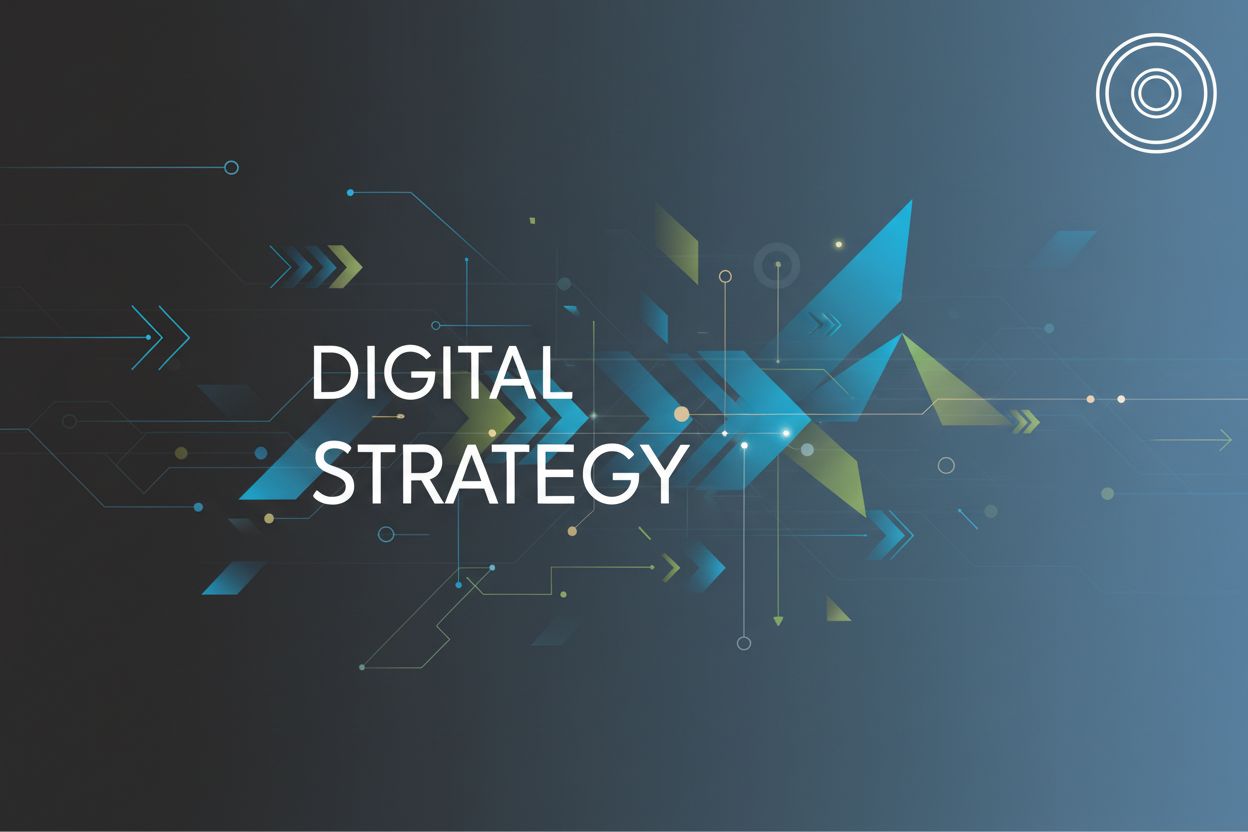Top 7 Types of Digital Marketing Strategies
TL;DR
Understanding the Digital Marketing Landscape
Alright, so you wanna dive into the world of digital marketing? It's not just throwing spaghetti at the wall to see what sticks, promise. It's about understanding the landscape, which is, like, constantly shifting due to new tech, changing customer habits, and algorithm updates.
Think of digital marketing as your online handshake, your digital storefront, and your 24/7 salesperson all rolled into one. It's how businesses connect with potential customers using the internet and other forms of digital communication. And it's not optional anymore; it's essential. As snhu.edu puts it, digital marketing has become vital to an organization's overall marketing efforts in the last decade. (Setting the future of digital and social media marketing research)
So, what makes a good digital marketing strategy? It's more than just posting memes on social media, I swear! Here's the gist:
- Know Your Audience: Figure out who you're trying to reach and where they hang out online. Are they glued to tiktok, or are they more of a LinkedIn crowd? Knowing this is half the battle. You can figure this out using website analytics, customer surveys, and by checking out what your competitors are doing.
- Set Goals: What are you trying to achieve? More website traffic? More sales? Make sure they're measurable, like increasing leads by 20% in the next quarter. Otherwise, you're just guessing. This is where the SMART goal framework comes in handy: Specific, Measurable, Achievable, Relevant, and Time-bound.
- Map the Journey: Think about the steps your customers take before making a purchase. What are their pain points? What questions do they have? What are they looking for?
One of the coolest things about digital marketing is that you can track almost everything. How many people clicked on your ad? How long did they spend on your website? Which pages did they visit? This data is pure gold, honestly. Use it to tweak your strategy and make it even more effective.
Now that we have a grasp of the overall landscape, let's dive into the foundational elements, starting with Search Engine Optimization.
1. Search Engine Optimization (SEO): The Foundation
Alright, so you've heard of SEO, right? It's not some magic spell, but it can feel like it when your website suddenly starts climbing up the search rankings. Think of it as laying the groundwork for everything else you're gonna do in digital marketing.
Basically, Search Engine Optimization is all about tweaking your website so that Google (and other search engines, but let's be real, mostly Google) loves it. It's about understanding what people actually search for and then making sure your site shows up when they search for that stuff.
- Think keyword research. What words and phrases are your potential customers typing into Google? Are they searching "best Italian restaurant near me" or something more specific like "gluten-free pasta downtown"? You gotta know what they're looking for!
- It's also about making your website easy for Google to crawl and understand. That means good site structure, fast loading times, and mobile-friendliness. Honestly, if your site takes forever to load, people are gonna bounce anyway; Google knows this. This includes technical SEO, but also on-page optimization (like using relevant keywords in your content) and off-page factors (like building quality backlinks).
Now, it's not just about stuffing keywords into your content until it sounds like a robot wrote it. Google's way smarter than that. It's about creating high-quality, valuable content that people actually want to read. Google's Beginners Guide to SEO, along with resources from Moz, emphasizes that SEO covers many elements, from the words on your web pages to the way other sites link to you. (On-Page SEO [Beginner's Guide to SEO] - Moz)
Let's say you're a local bakery specializing in custom cakes. A good SEO strategy might involve creating blog posts about cake decorating tips, optimizing your Google Business Profile with photos and customer reviews, and building backlinks from other local businesses.
SEO is a long-term game, okay? It's not a quick fix, but the results can be HUGE.
Next up, we'll talk about how to get that instant traffic with pay-per-click advertising.
2. Pay-Per-Click (PPC) Advertising: Instant Visibility
Pay-per-click, or PPC, is where you can get instant visibility, unlike SEO, which is more of a slow burn, as previously discussed.
Basically, you bid on keywords and pay only when someone clicks your ad. It's like renting the top spot on Google, but you gotta pay for the privilege. High competition keywords, meaning many people are searching and many sites are trying to be found for them, will be more expensive. Lower competition terms will likely cost less, according to snhu.edu. This is due to bidding wars where advertisers compete for ad placement.
- Google Ads: Think of this as the king of the PPC hill! You create campaigns, choose keywords, write ads, and set a budget. Google does the rest.
- Social Media Advertising: Platforms like Facebook, Instagram, and LinkedIn let you target specific demographics, interests, and behaviors. So if you're selling, say, vegan dog treats, you can target dog owners who are interested in healthy eating. Cool, right? While social media advertising often uses a PPC model, it's distinct from search engine PPC in its targeting and ad formats.
It's not just about throwing money at Google and hoping for the best. You need a strategy, friend.
- Targeted Campaigns: Don't just target broad keywords like "shoes." Get specific! If you're selling running shoes, target "best running shoes for marathon training."
- Compelling Ad Copy: Your ad needs to grab attention and make people want to click! Use strong verbs, highlight benefits, and include a call to action.
- Landing Page Optimization: Sending people to a generic homepage? Big mistake! Your landing page should be relevant to the ad and encourage conversions.
- Negative Keywords: These are crucial for filtering out irrelevant traffic. For example, if you sell high-end watches, you'd add "cheap" or "toy" as negative keywords to avoid clicks from people looking for something else.
You can blow through your budget real fast if you're not careful.
One of the other things that differentiate pay-per-click from SEO is that you only pay for the results.
In a typical PPC model like a Google Adwords campaign, you will pay only when someone clicks on your ad and lands on your website.
Keep a close eye on your campaigns, adjust your bids, and use negative keywords to filter out irrelevant traffic. Trust me on this one.
Up next, we'll dive into content marketing – a strategy that's all about creating valuable, engaging stuff that people actually want to consume.
3. Content Marketing: Building Authority and Engagement
Content marketing is about crafting stuff people ACTUALLY wanna read, watch, or listen to. Forget the hard sell; think "how can i help?" You have to identify what your audience needs. Like, what keeps them up at night? What questions do they have?
- Blogs and Articles: These are your bread and butter for SEO. Let’s say you run a financial planning firm. Instead of just pushing your services, write articles about "tax-efficient retirement strategies" or "budgeting tips for young professionals." Distribute these via social media, email newsletters, and guest blogging on relevant industry sites.
- Infographics and Visuals: People are visual creatures, right? A healthcare company could make an infographic breaking down the benefits of different types of health insurance plans – way easier to digest than a wall of text. Share these across all your channels and encourage social sharing.
- Videos and Webinars: These are gold for education and entertainment. A software company might host a webinar demonstrating how to use their product to solve a common problem. Promote these through email campaigns and social media ads, and then repurpose snippets for shorter social posts.
Distribution is just as important as creation, if not more. Sharing content on social media is a no-brainer, but don't forget email marketing to push out new content. Guest blogging and syndication can also get your content in front of new eyes.
Next up, we'll talk about social media marketing, which is, like, content marketing's louder, flashier cousin.
4. Social Media Marketing: Connecting with Your Audience
Social media marketing, or "smm" as the kids probably call it, is way more than just posting selfies and hoping for the best. It's about building a real connection with your audience. Think of it as your digital handshake, but with the potential to reach thousands—or even millions—of people.
First things first; you have to figure out where your audience actually hangs out, right? I mean, no point in shouting into the void. Are they all about the visuals on Instagram, or do they prefer the professional vibes of LinkedIn? Maybe they're glued to tiktok for bite-sized entertainment.
- Know Your Platform: Each platform has its own vibe, its own unspoken rules. akasa institute notes that you should use platform-specific content formats, which is something to consider before focusing on any platform. For example, short, engaging videos work well on TikTok and Instagram Reels, while longer-form articles and professional updates are better suited for LinkedIn.
- Consistency is Key: Once you've picked your platforms, stick with it. I've seen brands spread themselves too thin trying to be everywhere at once, and it never works.
It's not a one-way street, you know? Social media is about interaction, about building a community.
- Talk Back: Respond to comments, answer questions, and show that you're actually listening. I mean, it sounds obvious, but you'd be surprised how many brands just ignore their followers.
- Run Contests and Giveaways: People love free stuff, okay? It’s a simple way to boost engagement and grow your followers.
- Real Engagement: It's not just about vanity metrics like likes and followers, though those are nice too. It's about real engagement, about people actually caring about what you have to say. This includes comments, shares, saves, and click-throughs to your website.
You gotta track what's working and what's not. It's not just about vanity metrics like likes and followers, though those are nice too. It's about real engagement, about people actually caring about what you have to say.
Moving on from social media, next up we're gonna chat about email marketing. Trust me; it's not dead yet.
5. Email Marketing: Nurturing Leads and Driving Conversions
Okay, so email marketing...is it old school? Maybe a little. But don't count it out just yet, okay? It's still super effective for turning those maybe-interested folks into actual customers.
Think about it: social media's cool and all, but email's more personal. It's like a direct line to someone's inbox, ya know? Plus, you actually OWN your email list. Those followers on Insta can disappear tomorrow if the platform implodes. Not so with email.
- Targeted messages are a MUST. You can't just blast the same email to everyone. Segment your list based on their interests, location, past purchases – whatever makes sense for your business. For instance, a clothing retailer might send a special discount on winter coats to customers in colder climates. Segmentation is important because it allows you to send more relevant messages, which leads to higher open rates, click-through rates, and ultimately, more conversions.
- Personalization goes a long way. It's not just about slapping their name on the email, though that's a start. Use data to make the message relevant, like "Hey [Name], we noticed you liked our hiking boots..." You can also personalize based on their engagement level (e.g., sending a special offer to a loyal customer) or their expressed interests (e.g., sending content about a specific product category they've browsed).
- Automate, automate, automate. Set up welcome emails, abandoned cart reminders, birthday offers – the works. An e-commerce store might automatically send a coupon code to customers who left items in their cart.
Of course, you gotta track what's working. Are people opening your emails? Clicking on the links? Unsubscribing in droves? Pay attention to those metrics, and tweak your strategy accordingly.
Next up, let's get into influencer marketing. It's not as simple as paying some celeb to hold your product, I promise.
6. Influencer Marketing: Leveraging Trusted Voices
Okay, so you've got your SEO humming and social media buzzin'–but what about tapping into the power of influence, you know? I'm talking about influencer marketing. It's like borrowing a little bit of trust from someone who already has it in spades.
You gotta find influencers who actually vibe with your brand, not just someone with a huge following. For instance, a sustainable clothing brand should partner with influencers passionate about ethical fashion and enviromentalism.
It's not just about reach, though that's important. Engagement is key. Are their followers leaving thoughtful comments, or just heart emojis? Cause, tbh, you want real convos, not bots!
Think beyond the usual suspects. Micro-influencers (those with smaller, niche audiences) can sometimes offer better engagement and a more authentic connection. This is often because their followers feel a stronger sense of community and trust with them, leading to higher perceived authenticity and more meaningful interactions.
Give influencers creative freedom! If they are constantly using a product in their daily life, then the promotion will feel genuine. However, it's also important to provide clear briefs and expectations regarding campaign goals, messaging, and deliverables to ensure alignment.
Use UTM parameters (those little tags you add to links) to track where traffic and sales are coming from, so you know what's working.
Don't be afraid to ask for their input. They know their audience best. They might have ideas for content that really resonates.
It's not as simple as paying a celeb to flash your logo. It's about building relationships and finding voices that genuinely align with your brand. Now, let's move on to something that works hand-in-hand with influencer marketing: affiliate marketing.
7. Affiliate Marketing: Performance-Based Partnerships
Affiliate marketing is kinda like having a sales team that only gets paid when they actually, y'know, make a sale. Pretty sweet deal, right? It's all about partnerships and performance.
- You team up with affiliates (bloggers, influencers, even other businesses) who promote your products or services. They get a unique link, and when someone clicks that link and buys something, they earn a commission.
- It's like a win-win situation. You get extra exposure and sales, and your affiliates get paid for their efforts. Think of it as a digital handshake where everyone benefits.
- For example, a fitness brand might partner with a health and wellness blogger. The blogger reviews their protein powder, includes the affiliate link, and gets a cut of every sale that comes through their site.
It might seem like affiliate marketing is easy, but there are some things to keep in mind.
- You need to find the right affiliates, people who genuinely align with your brand and whose audience is likely to be interested in what you're selling.
- Setting up a clear and fair commission structure is also super important, so everyone knows what to expect and there aren't any surprises down the road.
- Tracking and Management: It's crucial to have a system in place to track affiliate sales accurately and manage your affiliate relationships effectively. This ensures fair payouts and helps identify your top-performing partners.
- Legal and Ethical Considerations: Be aware of disclosure requirements (e.g., FTC guidelines) and ensure your affiliates are transparent about their partnerships.
It’s gonna be tempting to only focus on the big influencers. Keep in mind that micro-influencers can sometimes offer better engagement and a more authentic connection.
Coming up next, we'll explore video marketing.
Integrating Strategies for Maximum Impact
Alright, so you've got all these strategies, but how do you make 'em actually work together? It's not just about checking boxes; it's about synergy, baby!
- Think of SEO as your foundation, attractin' folks searchin' for answers. Then, content marketing steps in to build trust and keep 'em engaged with valuable information.
- PPC ads can drive immediate traffic to your well-optimized content or landing pages, while social media amplifies your message and connects with your audience on a personal level. It's not just broadcastin', it's a conversation!
- And don't forget email marketing, the unsung hero for nurturing leads generated from all these channels and drivin' conversions with tailored messages. It's still got it!
For instance, a healthcare provider might use SEO to rank for "best local doctors," then create blog content answering common patient questions (content marketing). They'd promote these articles on Facebook (social media) to reach a wider audience and drive traffic to the blog. Then, they could use email marketing to send follow-up information or appointment reminders to people who engaged with the content. See how it all connects?
Conclusion: Charting Your Digital Marketing Success
Alright, so you just devoured a whole buffet of digital marketing strategies, huh? Feels kinda overwhelming, I get it.
- Remember that SEO and content marketing is like planting seeds – it takes time, but the payoff is HUGE, as mentioned earlier.
- PPC and social media ads are your instant gratification tools, great for quick boosts and targeted campaigns.
- Don't sleep on email marketing, though! It's still a powerhouse for nurturing leads and get real conversions.
The digital world never stops evolving, so make sure you're always learning and tweaking your approach. Now, go out there and make some magic happen!




